 to a lowercase "cygnus" with
a hand-drawn stripe under the "gnu" in the middle of the word, which you
can see below in our marketing literature.
to a lowercase "cygnus" with
a hand-drawn stripe under the "gnu" in the middle of the word, which you
can see below in our marketing literature. Cygnus Support was a small company founded to support and improve free software. We started with three people -- Michael Tiemann, David Vinayak Wallace, and John Gilmore. (David's nickname from MIT was "Gumby", and many people know him that way. After David married Silke Henkel, he became David Henkel-Wallace.) It grew to employ more than 120 people, with annual revenues over $20,000,000, ten years later. It was merged into Red Hat Software as Red Hat's second acquisition, in a time when Red Hat's revenues were much smaller, but its market capitalization was much greater (due to the tech and Linux stock market bubbles). The company was sold for about $600 million, making all of its early employees into millionaires.
There's lots more that could be written about Cygnus, but this page is to show the evolution of how we marketed free software.
When we started, "open source" had not been invented. "Free software" was known to a small but growing community, largely from universities and startup computer companies. The GNU C compiler reliably compiled itself, and produced good quality code, on the DEC Vax and the Motorola 68000. The Linux kernel had not been created. Berkeley Unix was still largely unfree (though I had made it compile with GCC in 1989, eliminating their big dependency on the unfree Portable C Compiler). GNU C++ was limping but unreliable. The GNU Lesser Public License did not exist.
We had the grandiose idea that major computer companies like Sun, SGI, and DEC would fire their compiler departments and use our free compilers and debuggers instead, paying us a million dollars a year for support and development. That wasn't quite right, but before we starved, we stumbled into the embedded systems market, doing jobs for Intel (the i960, a now-forgotten RISC chip), AMD (their now-forgotten but nice 29000 RISC), and various companies like 3Com and Adobe who had to port major pieces of code to these chips. In that market, once we fixed the tools to support cross-compiling, we had major advantages over the existing competitors, and we swarmed right through the market for 32-bit embedded system programming tools. And ultimately, we did get million-dollar contracts, such as one from Sony for building Playstation compilers and emulators. This allowed game developers to start working a year before the Playstation hardware was available. This enabled the Playstation to come to market sooner, with more and better games.
Cygnus started in David's 2-bedroom apartment on University Avenue in Palo Alto, California. When we outgrew the apartment, we rented more apartments in the same friendly (24-apartment) complex. Eventually Cygnus rented four apartments, and employees rented another three or four. When the Internet became available to ordinary people (without a government contract), we partnered with two other small businesses, rented leased lines, built or bought routers, and put ourselves on the Internet. We quickly snaked 10Base-2 coaxial Ethernet cables to each building in the complex, making it an attractive destination for high-tech friends to move into, whenever some other tenant moved out.
We expanded to the East Coast by hiring some Cambridge, Massachusetts hackers, who had expertise in Kerberos, MIT's network security software. We made a product out of that for a few years, and ported it to work reliably on many different systems.
We eventually outgrew the apartment complex. It didn't have a big enough room for all of us to gather in, and the arbitrary division of space into bedrooms, living rooms and kitchens made it hard to keep collaborators near each other. Our office manager, hacker support specialist Paula Vancini, scouted many dozens of places, and turned up an amazing space with 30-foot ceilings, big beams, skylights, and lots of space and offices, in a complex just off Highway 101 and Rengstorff Avenue in Mountain View, between the Sun and SGI corporate campuses. That was our Landings Drive office. I left the company in 1996 while it was still there.
One way we stood out was by making our stationery and our marketing literature in "A4" size, that is, slightly taller and slightly skinnier than the customary US "letter" size. This, we thought, not only made us look more "European" or "international", but also meant that if our paperwork was in a stack with others', ours would stick out and be visible.
Our marketing message was "Freedom". Freedom from restrictive software licenses, and technological license managers that would make your compiler refuse to run. (Yes, "DRM" was alive and well in the early 1990s, but only on expensive commercial software, not on music, movies, and books.) Freedom from lock-in to a specific vendor. Freedom from the constraints of currently available products: we were happy to modify them for you, for a price, and if you didn't like our price or our work, you could do it yourself, or hire anybody else to modify them for you.
We symbolized that freedom with pictures of puffy white clouds in a blue sky. That image was everywhere: on the back of our business cards, on the back of our A4 stationery, on the insides of our envelopes, on our banners and trade show displays, and on the covers of our boxed software and manuals.
We hired design consultants who remade our logo from its original
amateur "Cadillac chrome style" version
 to a lowercase "cygnus" with
a hand-drawn stripe under the "gnu" in the middle of the word, which you
can see below in our marketing literature.
to a lowercase "cygnus" with
a hand-drawn stripe under the "gnu" in the middle of the word, which you
can see below in our marketing literature.
Years later, "professional" marketing people decided that "Cygnus Support" was a weird name for a company. We had called it that to always remind us that supporting our customers was our #1 job. (Our customers weren't locked-in to us; they were free to go. We had to work hard to make sure they wanted to keep paying us for our support.) These marketing types held a contest for a new name for the company. Thousands of names were suggested. Ultimately they never found a better one, so to justify the whole charade, they called it "Cygnus Solutions", tacking on a buzzword of the era.
Later, after hiring more experienced executives, we discovered that our pricing was "leaving money on the table". We still needed to estimate our own costs and overheads and profits -- but we also needed to estimate how much money our work would SAVE our customer, or MAKE FOR our customer. When there was a big discrepancy in those two numbers, we could raise our price significantly, and the customer would still be happy. For example, the Sony PlayStation contract enabled Sony to ship the PlayStation months earlier (with working third party game software). Even a single month earlier of shipments would result in hundreds of millions of dollars of income for Sony. Similarly, big networking vendors like Cisco had tens or hundreds of millions of dollars riding on the introduction dates of their new products. We were selling them "insurance": if any big problems came up in the development software as they worked on the product, we'd fix them rapidly so their engineers would be able to deliver the product on time. Chip vendors, for whom we built many compilers, were betting big money on getting at least one large customer for their latest chip. Early availability of our tools allowed their customers to reliably prototype large, complex products with the chip. Our pricing gradually grew to include a percentage of the value that our work was creating out in the world, for our customers.
Here is a July 1990 Company Overview in readable TeX word processor input language. It's easy to read it as ordinary text. The lines that begin with "%" are commented out, i.e. they don't appear in the final document seen by the customer.
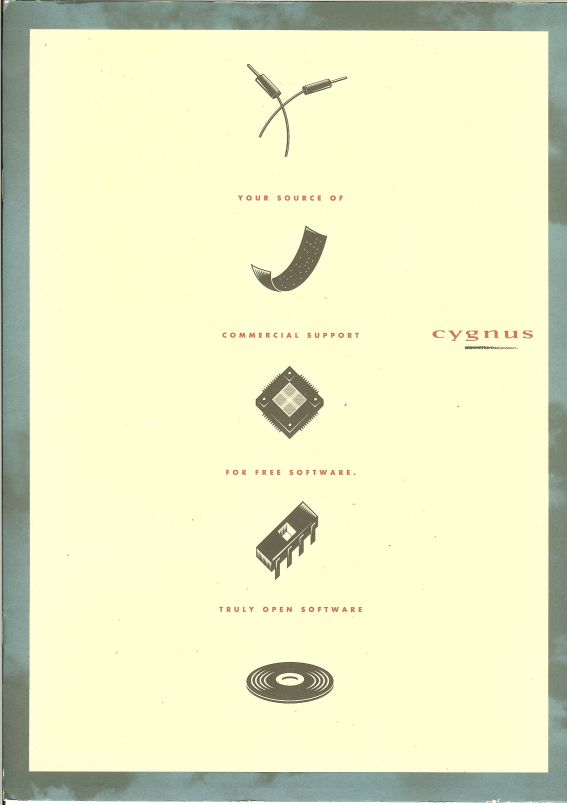
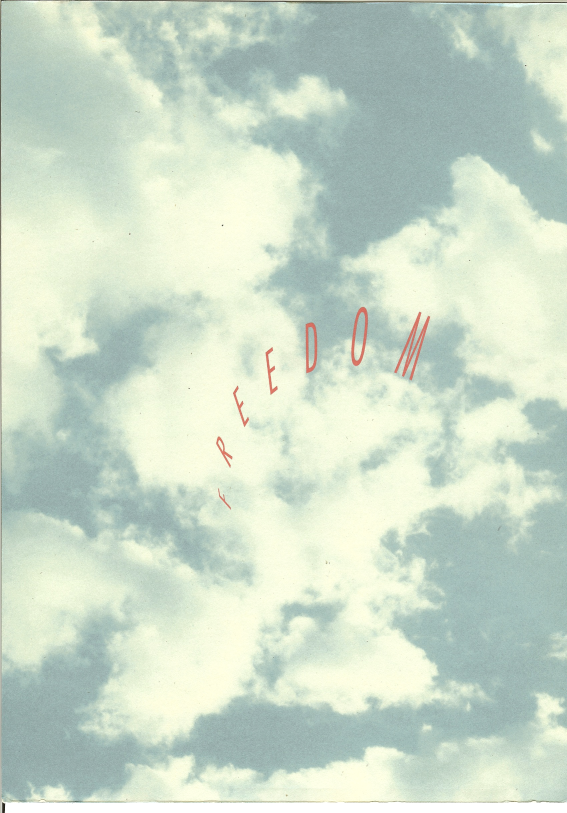
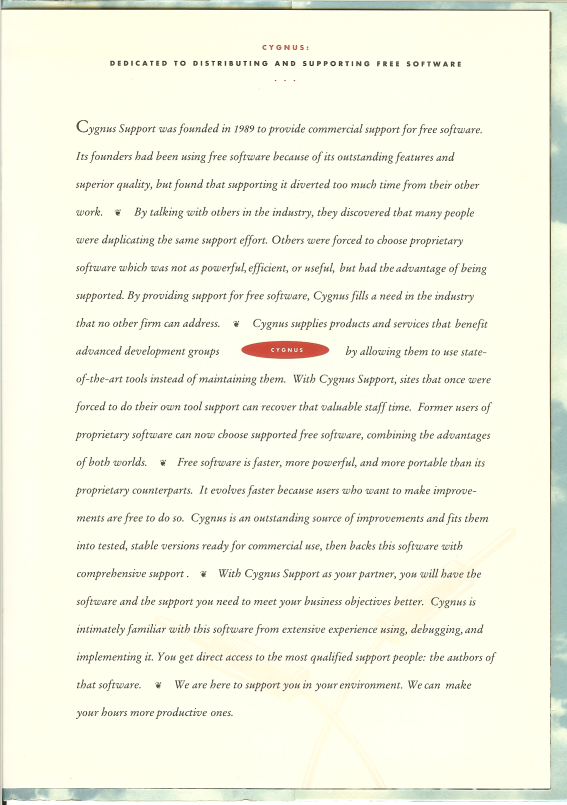
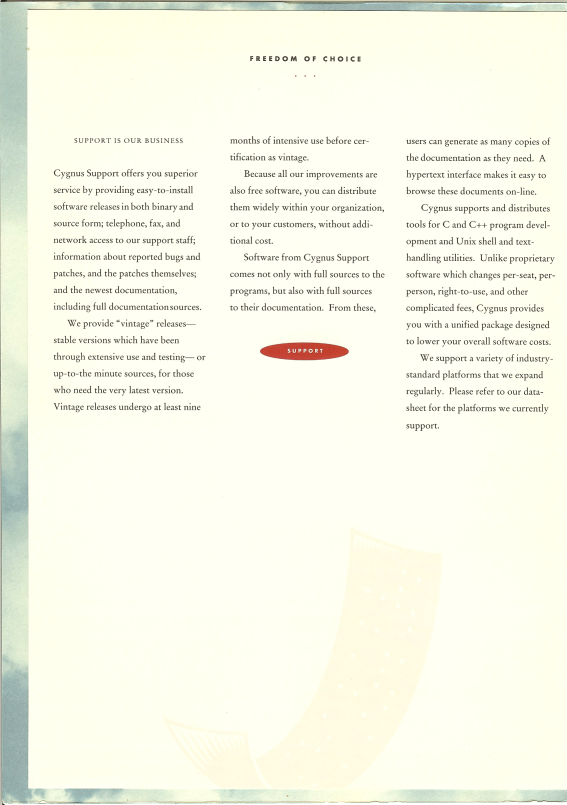
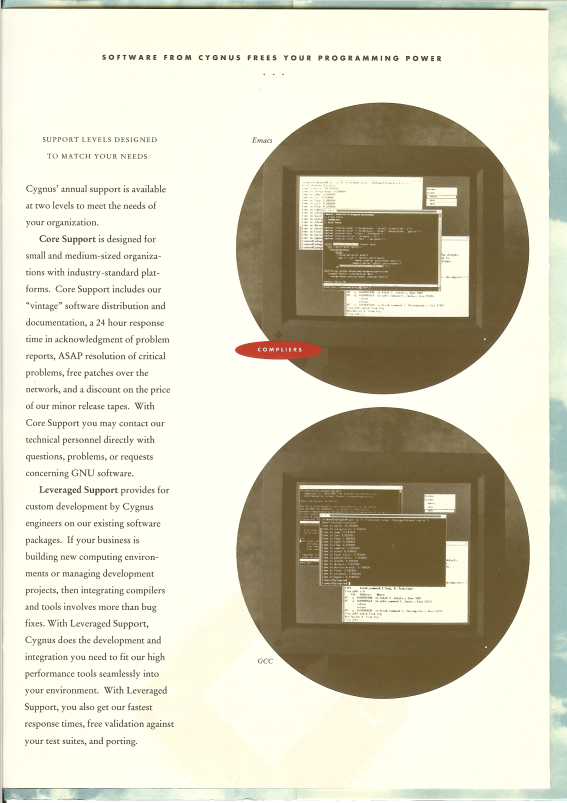
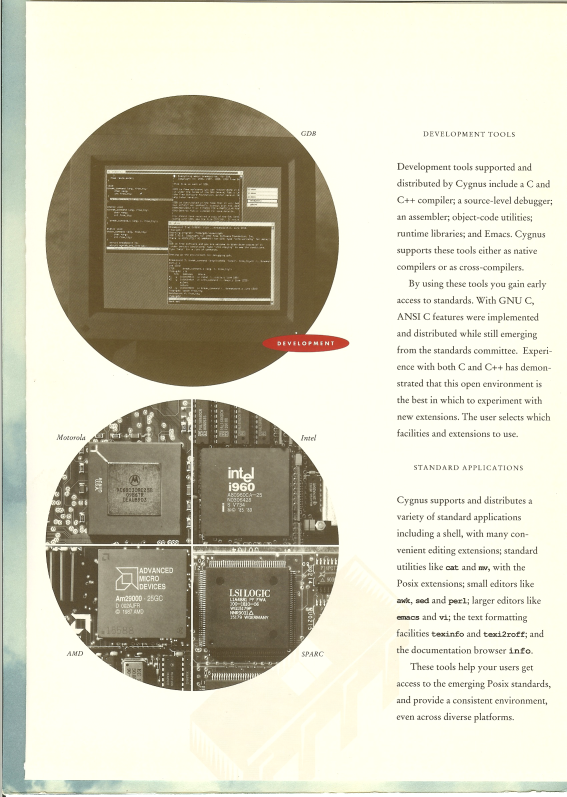
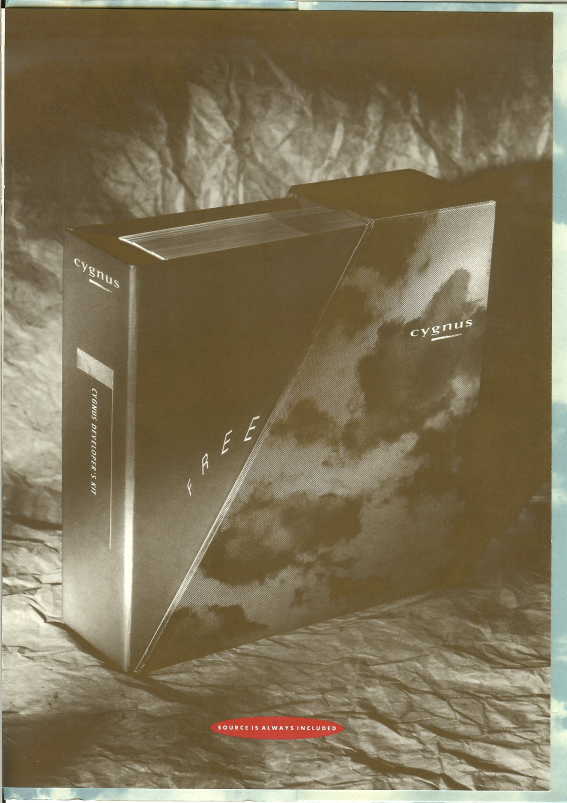
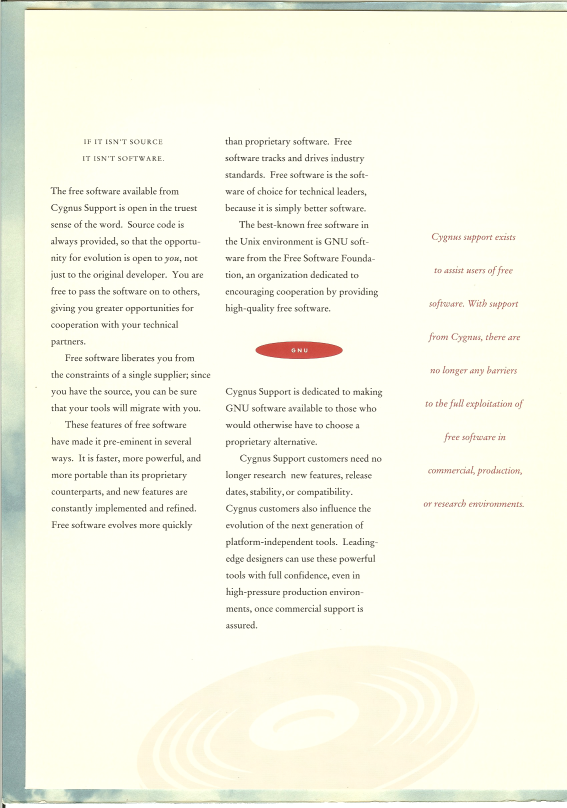


"Free Software" was a confusing term for the commercial market. It tended to make people think that we were trying to sell them something for nothing (i.e. a scam) or that our products and services weren't worth anything. We cast about for a better term and came up with "Sourceware". Software that came with source code was sourceware. We used the term, and even registered the domain sourceware.com, but it never caught on. Others with the same issue settled on Chris Peterson's term, "open source" in about 1998.
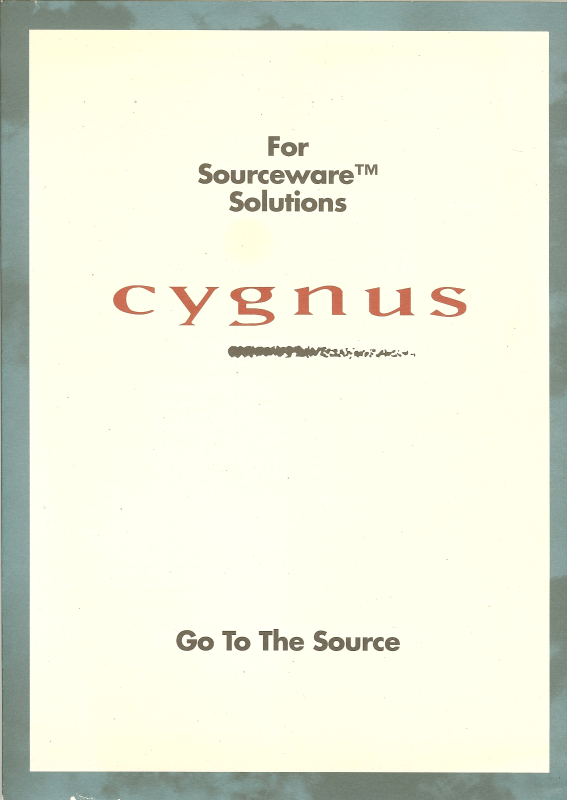
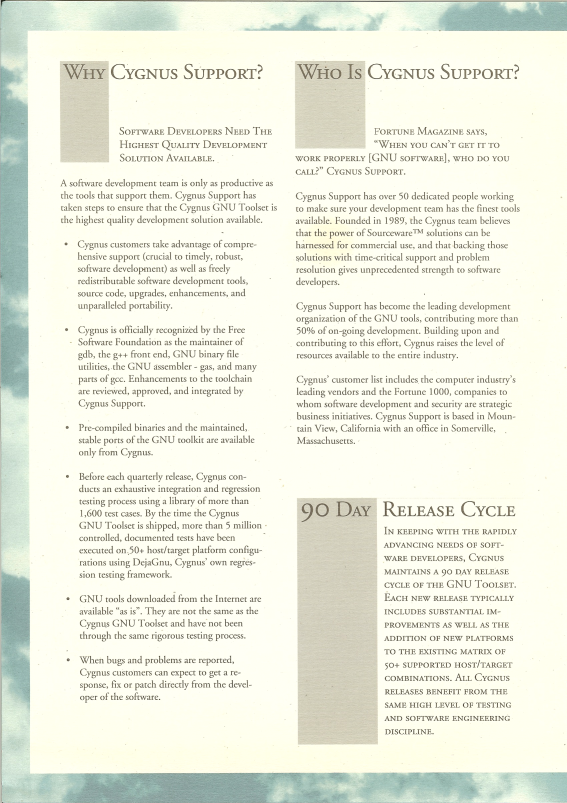
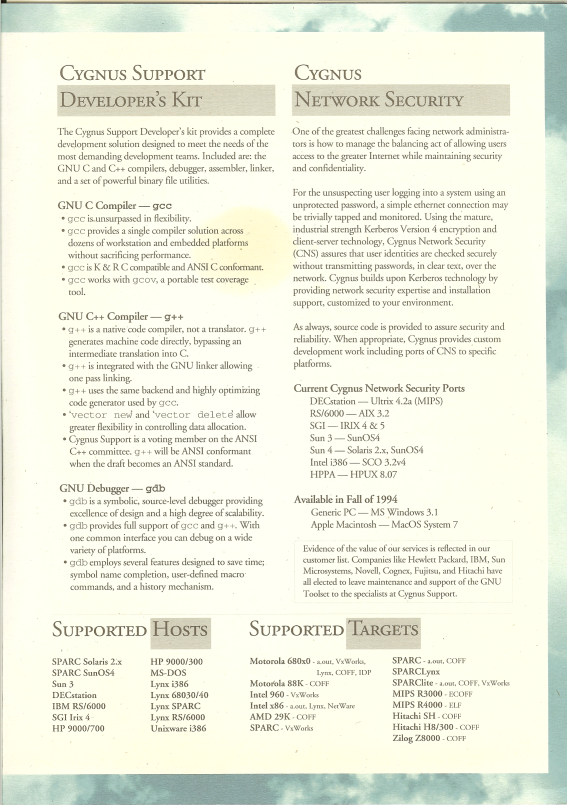
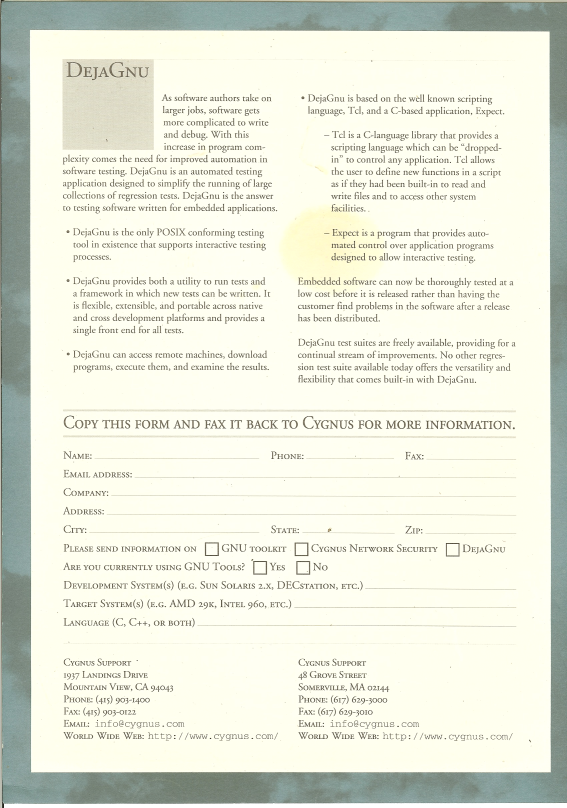
Here is the list of available issues of the Free Software Report, as published by Cygnus, all in postscript form. The lists of topics covered are not comprehensive; all issues have brief mentions of other subjects.
Volume 1, number 1. 1992. Articles by Cygnus and Michael Shapiro introducing free software as a business model; Wind River and GNU development tools; article on unix freeware versus MS-DOS and Macintosh freeware and shareware; GNU development tools for Solaris.
Volume 2, number 1. 1993. Article comparing various legal terms for free software; E-mu and GNU development tools; John Perry Barlow on intellectual property in cyberspace; free software in numerical computation.
Volume 2, number 2. 1993. Article comparing automobiles with software (lean versus mass manufacturing in automobiles, and proprietary versus free software); the WAIS, Inc., provider of internet search tools; the Andrew user interface system; the Yggdrasil linux company.
Volume 2, number 3. 1993. Free software and open systems (particularly networking standards and Novell); the GNU debugger gdb; Pegasus mail, a free mail program for Novell networks.
Volume 3, number 1. 1994. Regression testing; regression testing of unix systems; dejagnu, a free regression testing framework; testing Nascent, a fortran compiler.
Some kind customer has put the GNUPro Toolkit from 1996 Q4 (the fourth quarterly release of the year) on the net for public access.
Here it mentions the Free Software Report, Inside Cygnus Engineering, and Cygnus's Technical Reports. Unfortunately we did not put all of those into the release. I will find these and put them into this web site when I get a chance.
Thanks to the blessed Internet Archive, various copies of the GNUPro Toolkit Documentation have been archived and made available to the public. Here is the first one in the archive, from 1997.